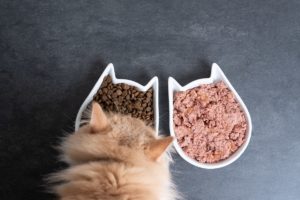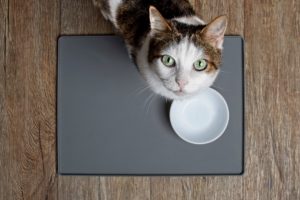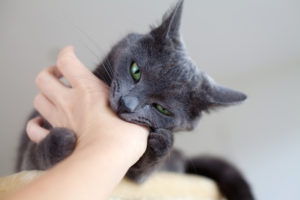No one likes feeling constipated, including our cats. You might notice that your cats are having some difficulty when trying to use the litter box. Maybe they are struggling to get any stool to exit their body, and when they do, the pieces are abnormal and quite small, like little pebbles. It might not be a glamorous duty looking after your cat’s feces, but it’s a job that needs to be done!
Most cases of cat constipation aren’t all too serious and may be resolved at home with some massaging and a change of diet. Others might need a more official evaluation to determine the cause and best treatment mode.
You might already do this for yourself and not even realize you’re doing it when your stomach aches, but massaging around the bowels can help stimulate movement. This goes for cats too!
Keep reading to learn more about cat constipation and how palpations can help.
What Is Constipation in Cats Like?
If your cat is constipated, they might be having irregular bowel movements where little to nothing actually comes out. On average, a cat will defecate one to three times a day, so if you notice after two days that you aren’t picking up anything in the litter box, your cat might have constipation.
Constipation happens when feces get stuck in the large intestine and absorb too much water, becoming very dry and hard. It no longer moves easily through their intestine to be emptied.
One common reason for constipation is a lack of fiber in a cat’s diet. Let’s elaborate on the causes below:
Causes of Cat Constipation
Cat constipation is idiopathic, meaning there is no identifiable cause, but many factors can influence constipation. There are four common things that can lead to constipation that can be avoided with a watchful eye. Of course, it can happen to any cat, and you shouldn’t blame yourself.
Some frequent causes of constipation include:
- Improper diet: Like said above, if your cat is not getting a proper diet with enough fiber, constipation could occur. If your cat is dehydrated and not drinking enough water, constipation is more likely. Feeding your cat a diet high in fiber and protein can help regulate your cat’s bowel movements.
- Ingesting a foreign object: Your cat could consume something they aren’t supposed to, making it more difficult to pass through their intestines. Sometimes string from toys can get caught up in your feces, making it harder to pass. Hairballs can also assist in this obstruction. Pelvic
- injuries: If your cat’s pelvis is injured, the pelvic canal might become too narrow for objects to pass through easily, creating a build-up.
- Obesity: Studies have found that older, overweight cats with kidney disease were more likely to become constipated.
Symptoms of Cat Constipation
If your cat struggles with constipation, there are a few signs and symptoms you can look out for. Your cat relies on you to make medical decisions for them, so being mindful of your cat’s bowel movements means an easier time making a diagnosis. Trust us; no vet is going to think you’re weird for keeping track of your cat’s feces. Some symptoms of cat constipation are:
- Vocalizing and crying in their litter box
- Several days of an empty litter box
- Straining to defecate
- Hard and dry fecal matter
- Blood in the stool
- Lack of appetite
- Vomiting
- Small amounts of diarrhea
- Lethargy
If you notice any of these symptoms in your pet, you can reach out to AskVet to see what they think. If it seems to be an emergency and it has been going on for several days, reach out to your local veterinarian immediately.
How Do You Diagnose Constipation in Cats?
To better understand what’s happening with your cat, you should take them to your veterinarian’s office. There, your cat’s doc can provide x-rays, a physical exam, a rectal exam, blood work, ultrasounds, and might even massage your cat’s stomach to feel for any obvious blockage.
If these behaviors are new to you, going to the vet is your best option so you can learn about ways to help your cat. If you have a cat that is more prone to constipation, there are ways for you to help at home when it happens again. This is where a cat constipation massage comes in, also known as palpation.
What Is a Cat Constipation Massage?
During your cat’s physical exam, the veterinarian will likely palpate your cat’s stomach to feel for fecal matter built up in the colon or even for a full bladder of urine. To pass built-up fecal matter through the intestines, it needs to be soft. This can be helped with an abdomen massage, referred to lovingly as a cat constipation massage. But how does it work?
Before you try this at home, ask your vet about the specific methods they might suggest for your specific cat. By massaging your cat’s belly, you can help to stimulate movement and work to soften the obstruction. If at any point your cat seems to be distressed, you should look into other options to help soften their stool, as you may be causing more stress for them.
Treatment for Cat Constipation
While cat constipation massages can get things going, there are other treatment methods that you can use at the same time to help your little pal feel better. Your vet might recommend prescription wet food or potentially pumpkin puree. Pumpkin puree is loaded with fiber and moves nicely through your cat’s digestive system.
Ensuring that your cat is drinking enough water. Sometimes, a fountain-type bowl will look more enticing to our picky feline friends. Encouraging regular exercise can also help to regulate bowel movements — sounds like a good excuse to play with our cats!
Get Help at Home: AskVet
At the end of the day, we all want what’s best for our furry friends. If your cat is in pain, it’s no fun for anyone involved. Palpating on your cat’s stomach to determine if there is an issue might help you figure out underlying issues that your cat might be having.
If you are wondering about your cat’s health, you can hop on the AskVet app and please reach out to one of our Pet Coaches for help. Join AskVet to find the answers and support you need.

Sources:
Constipation | Cornell University College of Veterinary Medicine







